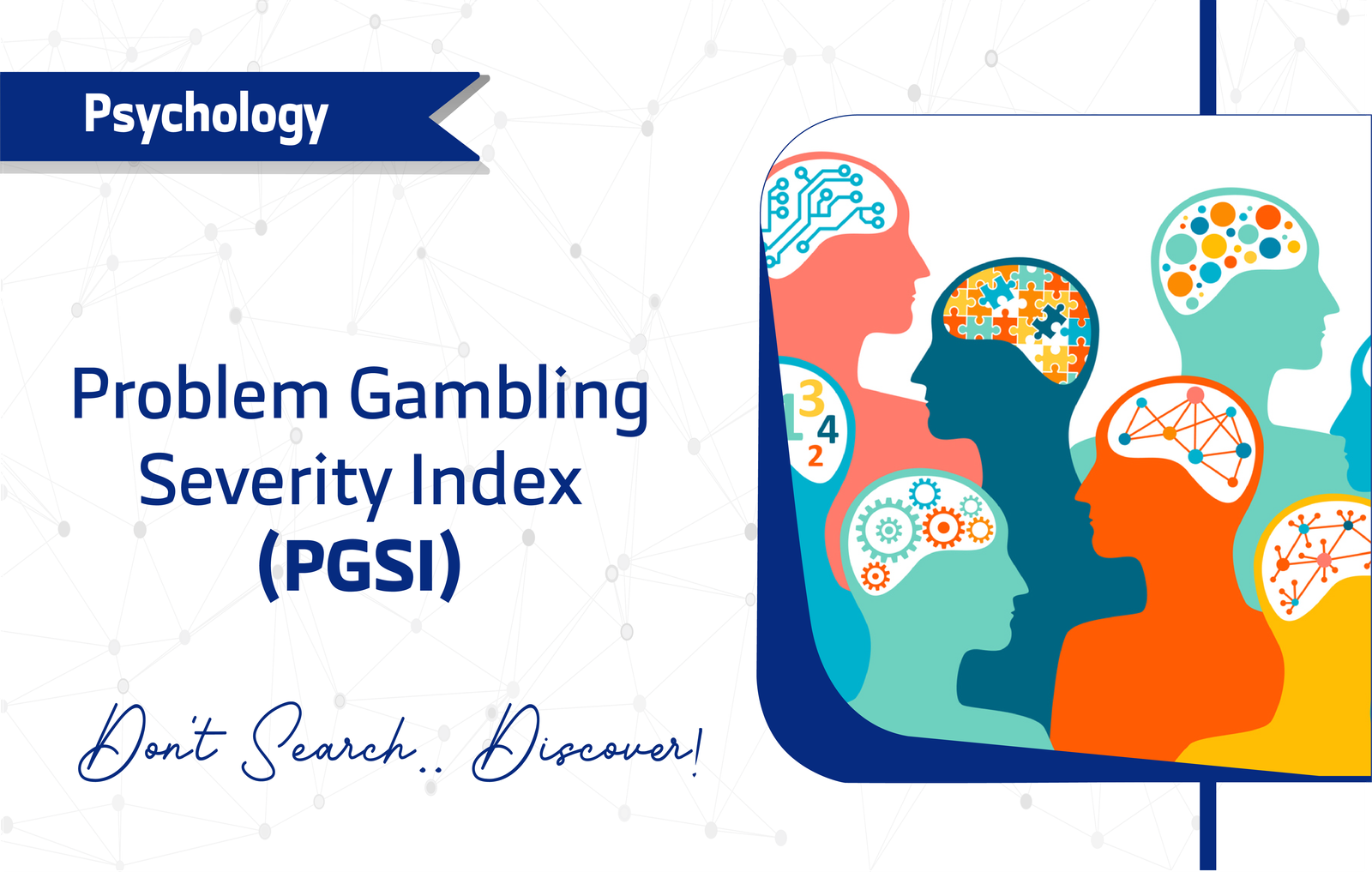Introduction
The Problem Gambling Severity Index (PGSI) is a vital public health and psychiatric screening instrument developed in 2001 by Julie Ferris and Harold Wynne. They designed it specifically to screen for and measure the severity of gambling-related problems within the general population. Its extensive use in research and clinical settings, supported by over 3,000 citations on Google Scholar, demonstrates its effectiveness and utility. This widespread adoption, therefore, underscores its status as a foundational tool for identifying at-risk individuals and guiding intervention strategies.
Consequently, this article offers researchers and clinicians a comprehensive overview of the PGSI‘s features, psychometric properties, applications, and limitations, providing actionable insights for its effective implementation.
Key Features of the Problem Gambling Severity Index (PGSI)
Purpose and Use
The primary purpose of the PGSI is to screen the general population for gambling-related problems and classify individuals into risk categories. Consequently, clinicians and public health officials use it to identify non-problem, low-risk, moderate-risk, and problem gamblers. This classification, in turn, informs public health strategies and interventions. Moreover, for researchers, it serves as a primary outcome measure in national surveys, such as the UK Gambling Survey.
Target Population
The PGSI is validated for adults aged 18 and older, including:
- Young adults (18–24 years)
- Middle-aged adults (25–44 years)
- Older adults (45–64 years)
- Seniors (65+ years)
Its broad applicability makes it suitable for diverse patient groups with chronic pain or musculoskeletal issues.
Structure
The PGSI is a concise, 9-item tool that evaluates gambling behavior and its consequences over the last 12 months. The questions cover a single domain of public health and psychiatry, with a specific subdomain focus on Gambling Behavior and Consequences. For example, items assess behaviors like betting more than one can afford to lose and the negative outcomes that may result, such as health issues or relationship strain.
Scoring Method
The PGSI employs a 4-point Likert response scale for each item, where scores range from 0 (“never”) to 3 (“almost always”). Afterward, respondents sum the scores from all nine items to produce a total score between 0 and 27. Based on this, individuals are classified into one of four distinct categories.
- 0: Non-problem gambler
- 1–2: Low-risk
- 3–7: Moderate-risk
- 8 or more: Problem
It is worth mentioning that the cut-off scores are as following:
- Score of 0: Non-problem gambling.
- Score of 1 or 2: Low level of problems with few or no identified negative consequences.
- Score of 3 to 7: Moderate level of problems leading to some negative consequences.
- Score of 8 or more: Problem gambling with negative consequences and a possible loss of control.
Administration Format
Administering the Problem Gambling Severity Index (PGSI) is remarkably efficient, typically taking less than 5 minutes to complete. In addition, it is a flexible tool that can be administered through various formats, including:
- Paper-based forms
- Digital online surveys
- In-person interviews
- Phone or video calls
Notably, the PGSI is self-administered and requires no special training, making it highly practical for busy clinical settings and research studies.
Applications of the Problem Gambling Severity Index (PGSI)
The PGSI is a versatile instrument with several key applications:
- Screening: It rapidly identifies individuals at risk of developing or experiencing gambling-related harm.
- Monitoring: Public health bodies use it to track the prevalence of problem gambling in the population over time.
- Research: It serves as a gold-standard measurement tool in studies examining gambling behaviors and the effectiveness of interventions.
Languages and Availability
To support its global application, the Problem Gambling Severity Index (PGSI) has been translated and validated in numerous languages, including:
- English
- Mandarin Chinese
- Spanish
- French
- Russian
- Japanese
The Canadian Centre on Substance Use and Addiction (formerly CCSA) publishes the PGSI and offers it under an open-access license. This licensing model ensures free access for non-commercial use.
Reliability and Validity
The PGSI is recognized as a highly reliable and valid instrument for assessing gambling severity. Its psychometric strength is demonstrated by a solid Cronbach’s alpha of 0.84, indicating good internal consistency. Additionally, it has shown strong test-retest reliability with a correlation coefficient of r = .78, confirming its stability over time.
Limitations and Considerations
Despite its strengths, the PGSI has a few limitations:
- Self-report measure: As a self-report measure, a patient’s subjective perception or recall bias may affect their responses.
- Cultural Bias: The interpretation of what constitutes problematic gambling behavior can vary across cultures, potentially affecting item relevance and validity.
- Social Desirability Bias: Responses may be influenced by a patient’s desire to present themselves in a favorable light, which is known as social desirability bias.
- Ambiguous Interpretation: Some items may be interpreted differently by respondents, which could lead to potential misclassifications.
Other Versions and Related Questionnaires
Alternative Versions of PGSI
- PGSI-Mini: a 3-item short form
- PGSI-Y: for youth populations.
Complementary Questionnaires
- South Oaks Gambling Screen (SOGS).
- DSM-IV.
- National Opinion Research Center DSM Screen (NODS).
Additional Resources
For more information on the PGSI and to access the full questionnaire, visit the following resources:
Frequently Asked Questions (FAQ)
- Who can use the Problem Gambling Severity Index?
Clinicians, public health officials, and researchers can use the PGSI for adults aged 18 and over to screen for gambling-related problems. - How long does it take to complete the PGSI?
The assessment can typically be completed in under 5 minutes, making it highly practical for large-scale surveys and busy clinical environments. - How is the PGSI administered?
The questionnaire is flexible and can be administered via paper-based forms, digital surveys, or through in-person, phone, or video interviews. - Is there any cost to using the PGSI?
The PGSI is free for non-commercial use and is available under an open-access license.
A word from ResRef about Problem Gambling Severity Index (PGSI)
The Problem Gambling Severity Index (PGSI) remains the gold standard for population-level gambling screening. However, clinicians should pair it with interviews to overcome limitations related to sensitivity and cultural interpretation. Ultimately, its strength lies in capturing a continuum of gambling severity, making it invaluable for public health research.
References
- Ferris, J., & Wynne, H. (2001). The Canadian Problem Gambling Index: Final Report. Canadian Centre on Substance Abuse (CCSA). link
- Lopez-Gonzalez, H., Estévez, A., & Griffiths, M. D. (2018). Spanish validation of the Problem Gambling Severity Index: A confirmatory factor analysis with sports bettors. Journal of Behavioral Addictions, 7(3), 814-820. link
- Currie, S. R., Hodgins, D. C., & Casey, D. M. (2013). Validity of the problem gambling severity index interpretive categories. Journal of gambling studies, 29, 311-327. link
- Miller, N. V., Currie, S. R., Hodgins, D. C., & Casey, D. (2013). Validation of the problem gambling severity index using confirmatory factor analysis and rasch modelling. International journal of methods in psychiatric research, 22(3), 245-255. link
- Holtgraves, T. (2009). Evaluating the Problem Gambling Severity Index. Journal of Gambling Studies, 25(1), 105–120. link
- Orford, J., Wardle, H., Griffiths, M., Sproston, K., & Erens, B. (2010). PGSI and DSM-IV in the 2007 British Gambling Prevalence Survey: reliability, item response, and factor structure. International Gambling Studies, 10(1), 31-44. link








